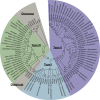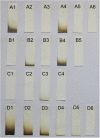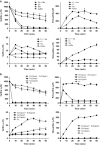Sulfide production and oxidation by heterotrophic bacteria under aerobic conditions
- PMID: 28777380
- PMCID: PMC5702731
- DOI: 10.1038/ismej.2017.125
Sulfide production and oxidation by heterotrophic bacteria under aerobic conditions
Abstract
Sulfide (H2S, HS- and S2-) oxidation to sulfite and thiosulfate by heterotrophic bacteria, using sulfide:quinone oxidoreductase (SQR) and persulfide dioxygenase (PDO), has recently been reported as a possible detoxification mechanism for sulfide at high levels. Bioinformatic analysis revealed that the sqr and pdo genes were common in sequenced bacterial genomes, implying the sulfide oxidation may have other physiological functions. SQRs have previously been classified into six types. Here we grouped PDOs into three types and showed that some heterotrophic bacteria produced and released H2S from organic sulfur into the headspace during aerobic growth, and others, for example, Pseudomonas aeruginosa PAO1, with sqr and pdo did not release H2S. When the sqr and pdo genes were deleted, the mutants also released H2S. Both sulfide-oxidizing and non-oxidizing heterotrophic bacteria were readily isolated from various environmental samples. The sqr and pdo genes were also common in the published marine metagenomic and metatranscriptomic data, indicating that the genes are present and expressed. Thus, heterotrophic bacteria actively produce and consume sulfide when growing on organic compounds under aerobic conditions. Given their abundance on Earth, their contribution to the sulfur cycle should not be overlooked.
Conflict of interest statement
The authors declare no conflict of interest.
Figures


 In Figure 2d, control Ec(pMCS5): sulfide, ○ thiosulfate, □ and sulfane sulfur,
In Figure 2d, control Ec(pMCS5): sulfide, ○ thiosulfate, □ and sulfane sulfur,  Sulfide oxidation, polysulfide production and thiosulfate production by E. coli with cloned Zppdo, Bcpdo or Sapdo were essentially the same as Ec(pMCS5) (Data not shown).
Sulfide oxidation, polysulfide production and thiosulfate production by E. coli with cloned Zppdo, Bcpdo or Sapdo were essentially the same as Ec(pMCS5) (Data not shown).


Similar articles
-
Cupriavidus necator H16 Uses Flavocytochrome c Sulfide Dehydrogenase To Oxidize Self-Produced and Added Sulfide.Appl Environ Microbiol. 2017 Oct 31;83(22):e01610-17. doi: 10.1128/AEM.01610-17. Print 2017 Nov 15. Appl Environ Microbiol. 2017. PMID: 28864655 Free PMC article.
-
Cytoplasmic Localization of Sulfide:Quinone Oxidoreductase and Persulfide Dioxygenase of Cupriavidus pinatubonensis JMP134.Appl Environ Microbiol. 2017 Nov 16;83(23):e01820-17. doi: 10.1128/AEM.01820-17. Print 2017 Dec 1. Appl Environ Microbiol. 2017. PMID: 28939597 Free PMC article.
-
Recombinant Escherichia coli with sulfide:quinone oxidoreductase and persulfide dioxygenase rapidly oxidises sulfide to sulfite and thiosulfate via a new pathway.Environ Microbiol. 2016 Dec;18(12):5123-5136. doi: 10.1111/1462-2920.13511. Epub 2016 Sep 23. Environ Microbiol. 2016. PMID: 27573649
-
Essential role of sulfide oxidation in brain health and neurological disorders.Pharmacol Ther. 2025 Feb;266:108787. doi: 10.1016/j.pharmthera.2024.108787. Epub 2024 Dec 22. Pharmacol Ther. 2025. PMID: 39719173 Review.
-
Roles, mechanism of action, and potential applications of sulfur-oxidizing bacteria for environmental bioremediation.Sci Total Environ. 2022 Dec 15;852:158203. doi: 10.1016/j.scitotenv.2022.158203. Epub 2022 Aug 28. Sci Total Environ. 2022. PMID: 36044953 Review.
Cited by
-
The Mechanisms of Thiosulfate Toxicity against Saccharomyces cerevisiae.Antioxidants (Basel). 2021 Apr 22;10(5):646. doi: 10.3390/antiox10050646. Antioxidants (Basel). 2021. PMID: 33922196 Free PMC article.
-
The Sulfide-Responsive SqrR/BigR Homologous Regulator YgaV of Escherichia coli Controls Expression of Anaerobic Respiratory Genes and Antibiotic Tolerance.Antioxidants (Basel). 2022 Nov 28;11(12):2359. doi: 10.3390/antiox11122359. Antioxidants (Basel). 2022. PMID: 36552568 Free PMC article.
-
MarR family proteins sense sulfane sulfur in bacteria.mLife. 2024 May 15;3(2):231-239. doi: 10.1002/mlf2.12109. eCollection 2024 Jun. mLife. 2024. PMID: 38948149 Free PMC article. Review.
-
The Transcriptional Repressor PerR Senses Sulfane Sulfur by Cysteine Persulfidation at the Structural Zn2+ Site in Synechococcus sp. PCC7002.Antioxidants (Basel). 2023 Feb 9;12(2):423. doi: 10.3390/antiox12020423. Antioxidants (Basel). 2023. PMID: 36829981 Free PMC article.
-
Sulfide-quinone oxidoreductase is required for cysteine synthesis and indispensable to mitochondrial health.Redox Biol. 2021 Nov;47:102169. doi: 10.1016/j.redox.2021.102169. Epub 2021 Oct 15. Redox Biol. 2021. PMID: 34688157 Free PMC article.
References
-
- Alcolombri U, Ben-Dor S, Feldmesser E, Levin Y, Tawfik DS, Vardi A. (2015). MARINE SULFUR CYCLE. Identification of the algal dimethyl sulfide-releasing enzyme: a missing link in the marine sulfur cycle. Science 348: 1466–1469. - PubMed
-
- Amin S, Hmelo L, van Tol H, Durham B, Carlson L, Heal K et al. (2015). Interaction and signalling between a cosmopolitan phytoplankton and associated bacteria. Nature 522: 98–101. - PubMed
-
- Anandham R, Indiragandhi P, Madhaiyan M, Ryu KY, Jee HJ, Sa TM. (2008). Chemolithoautotrophic oxidation of thiosulfate and phylogenetic distribution of sulfur oxidation gene (soxB) in rhizobacteria isolated from crop plants. Res Microbiol 159: 579–589. - PubMed
-
- Clarke PH. (1953). Hydrogen sulphide production by bacteria. J Gen Microbiol 8: 397–407. - PubMed
MeSH terms
Substances
LinkOut - more resources
Full Text Sources
Other Literature Sources
Molecular Biology Databases

